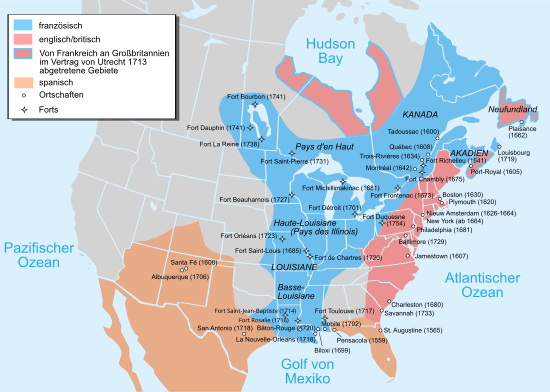Fort Michilimackinac
Fort Michilimackinac was an originally French , later British fortified trading post on the south coast of the strategically important Straits of Mackinac ( Mackinac Strait ) between Lake Huron and Lake Michigan in the area of today's city of Mackinaw City .
history
Fort Michilimackinac had less military and economic importance. It was a link in a chain of French trading posts that stretched from the Mississippi River through what is now the US state of Illinois to the Saint Lawrence River . The fort served as a base for fur traders in the west of the Great Lakes .
The first permanent French presence on Mackinacstrasse came about in 1671 when the missionary Jacques Marquette founded the Jesuit mission Saint Ignace (now called St. Ignace ), to which a fort was added in 1683. In 1701, however, the garrison was moved to Detroit ; the mission and fort were abandoned. In 1715, however, the French returned and built Fort Michilimackinac, a wooden fortification to control the strategically important Mackinac Strait.
In 1761 the fort was taken over by the British as one of the last French bases in North America, which was confirmed by the Peace of Paris of 1763. Nothing changed in terms of its function as a trading post. During the Pontiac uprising , in which the nearby Anishinabe also took part, a group of this tribe occupied the fort on June 2, 1763 and massacred most of the British garrison garrison. The Indians surprised the fort with a trick: They organized the game “stickball” (a preform of lacrosse ) in front of the gates of the fort. The soldiers of the fort watched the game as in previous situations. The ball was played through the open gate of the fort by the Indians and they ran after the ball. In the fort, they took up their weapons that Indian women had smuggled into them. About 15 of the 35 soldiers were killed, 5 others later martyred. It was the fifth fort to be captured during the Pontiac Uprising - and the largest fort in that conflict to be captured by surprise. It was only about a year later that the British were able to occupy the fort again. In 1765, Major Robert Rogers , who had made fame in the French and Indian War, was appointed commandant. From there, Rogers undertook a search for the Northwest Passage , the character of which is still controversial today. It is said that he wanted to build an independent republic. Rogers was eventually arrested for high treason in 1767 , but acquitted in the subsequent trial.
Since the wooden defenses were apparently considered too vulnerable, Fort Mackinac was built on nearby Mackinac Island in 1781 . After its completion, Fort Michilimackinac was abandoned.

The fort's site became a National Historic Landmark in October 1960 . Today it is a popular tourist attraction as part of Fort Michilimackinac State Park in Mackinaw City . After extensive archaeological research, some of the buildings were reconstructed. Fort Michilimackinac is now considered the best-explored site of early French colonization in the United States.
See also
Web links
- Michigan.gov: Fort Michilimackinac (engl.)
- Fort Michilimackinac Festival
- Michigan Historical Markers: Fort Michilimackinac (Eng.)
Remarks
- ↑ Listing of National Historic Landmarks by State: Michigan. National Park Service , accessed August 15, 2019.
Coordinates: 45 ° 47'9.8 " N , 84 ° 44'5" W.
